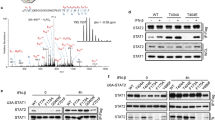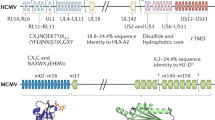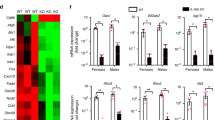Abstract
Virus-induced interferon (VIF), and immune interferon (IIF) produced by lymphocytes following activation by various mitogens (phytohaemagglutinin, concanavalin A, staphylococcal enterotoxin A) or by specific antigenic stimulation (tuberculin, bacterial toxoids, and viral antigens) show important functional differences. These include different antitumour1 and immunoregulatory activities2 and differential inhibition of activity by mercaptoethanol3. Another important difference has recently been shown: cells treated with IIF acquire the antiviral state much more slowly than those treated with VIF4. This may be due to (1) difference in cellular receptors, (2) presence of an inhibitor of antiviral activity in the IIF preparations, or (3) a different mechanism of activation of the antiviral state by the two types of interferon. The first two hypotheses seem unlikely, since (1) no difference between cell association by the two types of interferon has been detected4, and (2) the presence of the slow acting IIF preparation did not inhibit the rapid activation by VIF4. The present study shows that the different kinetics of induction of the antiviral state result from a major difference in the mechanism by which IIF and VIF activate cells.
This is a preview of subscription content, access via your institution
Access options
Similar content being viewed by others
References
Salvin, S. B., Youngner, J. S., Nishia, J. & Neta, R. J. J. natn. Cancer Inst. 55, 1233–1238 (1975).
Sonnenfeld, G., Mandel, A. D. & Merigan, T. C. Cell. Immun. 34, 193–206 (1977).
Johnson, H. M. Cell. Immun. 36, 220–230 (1978).
Dianzani, F., Salter, L., Fleischmann, W. R. Jr. & Zucca, M. Proc. Soc. exp. Biol. Med. 159, 94–97 (1978).
Taylor, J. Biochem. biophys. Res. Commun. 14, 447–451 (1964).
Samuel, E. C. & Joklik, K. W. Virology 58, 476–491 (1974).
Dianzani, F., Buckler, C. E. & Baron, S. Proc. Soc. exp. Biol. Med. 130, 519–523 (1969).
Dianzani, F. & Baron, S. Nature 257, 682–684 (1975).
Oie, H. K., Gazdar, A. F., Buckler, C. E. & Baron, S. J. gen. Virol. 17, 107–109 (1972).
Cantell, K., Strander, H., Hadazi, G. & Nevalinna, H. R. in The Interferon (ed. Rita, G.) 223 (Academic, New York, 1968).
Johnson, H. M., Stanton, G. J. & Baron, S. Proc. Soc. exp. Biol. Med. 154, 138–141 (1977).
Author information
Authors and Affiliations
Rights and permissions
About this article
Cite this article
Dianzani, F., Zucca, M., Scupham, A. et al. Immune and virus-induced interferons may activate cells by different derepressional mechanisms. Nature 283, 400–402 (1980). https://doi.org/10.1038/283400a0
Received:
Accepted:
Issue Date:
DOI: https://doi.org/10.1038/283400a0
This article is cited by
-
Regulation of cell growth by interferon
Cancer and Metastasis Review (1987)
Comments
By submitting a comment you agree to abide by our Terms and Community Guidelines. If you find something abusive or that does not comply with our terms or guidelines please flag it as inappropriate.



